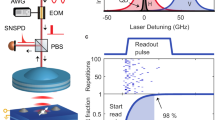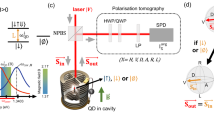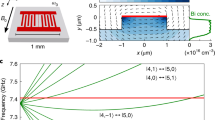Abstract
Solid-state quantum emitters have shown strong potential for applications in quantum information, but the spectral inhomogeneity of these emitters poses a significant challenge. We address this issue in a cavity–quantum dot system by demonstrating cavity-stimulated Raman spin flip emission. This process avoids populating the excited state of the emitter and generates a photon that is Raman shifted from the laser and enhanced by the cavity. The emission is spectrally narrow and tunable over a range of at least 125 GHz, which is two orders of magnitude greater than the natural linewidth. We obtain the regime in which the Raman emission is spin dependent, which couples the photon to a long-lived electron spin qubit. This process can enable an efficient, tunable source of indistinguishable photons and deterministic entanglement of distant spin qubits in a photonic-crystal quantum network.
This is a preview of subscription content, access via your institution
Access options
Subscribe to this journal
Receive 12 print issues and online access
$209.00 per year
only $17.42 per issue
Buy this article
- Purchase on Springer Link
- Instant access to full article PDF
Prices may be subject to local taxes which are calculated during checkout





Similar content being viewed by others
References
Cirac, J. I., Zoller, P., Kimble, H. J. & Mabuchi, H. Quantum state transfer and entanglement distribution among distant nodes in a quantum network. Phys. Rev. Lett. 78, 3221–3224 (1997).
Imamoğlu, A. et al. Quantum information processing using quantum dot spins and cavity QED. Phys. Rev. Lett. 83, 4204–4207 (1999).
Liu, R.-B., Yao, W. & Sham, L. J. Quantum computing by optical control of electron spins. Adv. Phys. 59, 703–802 (2010).
Ritter, S. et al. An elementary quantum network of single atoms in optical cavities. Nature 484, 195–200 (2012).
Knill, E., Laflamme, R. & Milburn, G. J. A scheme for efficient quantum computation with linear optics. Nature 409, 46–52 (2001).
Gisin, N., Ribordy, G., Tittel, W. & Zbinden, H. Quantum cryptography. Rev. Mod. Phys. 74, 145–195 (2002).
Yoshie, T. et al. Vacuum Rabi splitting with a single quantum dot in a photonic crystal nanocavity. Nature 432, 200–203 (2004).
Reithmaier, J. P. et al. Strong coupling in a single quantum dot–semiconductor microcavity system. Nature 432, 197–200 (2004).
Faraon, A., Santori, C., Huang, Z., Acosta, V. M. & Beausoleil, R. G. Coupling of nitrogen-vacancy centers to photonic crystal cavities in monocrystalline diamond. Phys. Rev. Lett. 109, 033604 (2012).
Weiss, K. M., Elzerman, J. M., Delley, Y. L., Miguel-Sanchez, J. & Imamoglu, A. Coherent two-electron spin qubits in an optically active pair of coupled InGaAs quantum dots. Phys. Rev. Lett. 109, 107401 (2012).
Greilich, A., Carter, S. G., Kim, D., Bracker, A. S. & Gammon, D. Optical control of one and two hole spins in interacting quantum dots. Nature Photon. 5, 702–708 (2011).
Kim, D., Carter, S. G., Greilich, A., Bracker, A. S. & Gammon, D. Ultrafast optical control of entanglement between two quantum-dot spins. Nature Phys. 7, 223–229 (2011).
Economou, S. E., Lindner, N. & Rudolph, T. Optically generated 2-dimensional photonic cluster state from coupled quantum dots. Phys. Rev. Lett. 105, 093601 (2010).
Park, Y.-S., Cook, A. K. & Wang, H. Cavity QED with diamond nanocrystals and silica microspheres. Nano Lett. 6, 2075–2079 (2006).
Sanaka, K., Pawlis, A., Ladd, T. D., Lischka, K. & Yamamoto, Y. Indistinguishable photons from independent semiconductor nanostructures. Phys. Rev. Lett. 103, 053601 (2009).
Fu, K.-M. C. et al. Ultrafast control of donor-bound electron spins with single detuned optical pulses. Nature Phys. 4, 780–784 (2008).
Hennrich, M., Legero, T., Kuhn, A. & Rempe, G. Vacuum-stimulated Raman scattering based on adiabatic passage in a high-finesse optical cavity. Phys. Rev. Lett. 85, 4872–4875 (2000).
Santori, C., Fattal, D., Fu, K.-M. C., Barclay, P. E. & Beausoleil, R. G. On the indistinguishability of Raman photons. New J. Phys. 11, 123009 (2009).
Kiraz, A., Atatüre, M. & Imamoğlu, A. Quantum-dot single-photon sources: prospects for applications in linear optics quantum-information processing. Phys. Rev. A 69, 032305 (2004).
Carter, S. G. et al. Quantum control of a spin qubit coupled to a photonic crystal cavity. Nature Photon. 7, 329–334 (2013).
Englund, D. et al. Controlling the spontaneous emission rate of single quantum dots in a two-dimensional photonic crystal. Phys. Rev. Lett. 95, 013904 (2005).
Noda, S., Fujita, M. & Asano, T. Spontaneous-emission control by photonic crystals and nanocavities. Nature Photon. 1, 449–458 (2007).
Ota, Y., Iwamoto, S., Kumagai, N. & Arakawa, Y. Spontaneous two photon emission from a single quantum dot. Phys. Rev. Lett. 107, 233602 (2011).
Greilich, A. et al. Mode locking of electron spin coherences in singly charged quantum dots. Science 313, 341–345 (2006).
Press, D. et al. Ultrafast optical spin echo in a single quantum dot. Nature Photon. 4, 367–370 (2010).
Berezovsky, J., Mikkelsen, M. H., Stoltz, N. G., Coldren, L. A. & Awschalom, D. D. Picosecond coherent optical manipulation of a single electron spin in a quantum dot. Science 320, 349–352 (2008).
Kim, E. D. et al. Fast spin rotations by optically controlled geometric phases in a charge-tunable InAs quantum dot. Phys. Rev. Lett. 104, 167401 (2010).
Sweeney, T. M., Phelps, C. & Wang, H. Quantum control of electron spins in the two-dimensional electron gas of a CdTe quantum well with a pair of Raman-resonant phase-locked laser pulses. Phys. Rev. B 84, 075321 (2011).
Fernandez, G., Volz, T., Desbuquois, R., Badolato, A. & Imamoglu, A. Optically tunable spontaneous Raman fluorescence from a single self-assembled InGaAs quantum dot. Phys. Rev. Lett. 103, 087406 (2009).
He, Y. et al. Indistinguishable tunable single photons emitted by spin-flip Raman transitions in InGaAs quantum dots. Phys. Rev. Lett. 111, 237403 (2013).
Francardi, M. et al. Enhanced spontaneous emission in a photonic-crystal light-emitting diode. Appl. Phys. Lett. 93, 143102 (2008).
Laucht, A. et al. Electrical control of spontaneous emission and strong coupling for a single quantum dot. New J. Phys. 11, 023034 (2009).
Pinotsi, D., Fallahi, P., Miguel-Sanchez, J. & Imamoglu, A. Resonant spectroscopy on charge tunable quantum dots in photonic crystal structures. IEEE J. Quantum Electron. 47, 1371–1374 (2011).
Rakher, M. T., Stoltz, N. G., Coldren, L. A., Petroff, P. M. & Bouwmeester, D. Externally mode-matched cavity quantum electrodynamics with charge-tunable quantum dots. Phys. Rev. Lett. 102, 097403 (2009).
Atatüre, M. et al. Quantum-dot spin-state preparation with near-unity fidelity. Science 312, 551–553 (2006).
Xu, X. et al. Fast spin state initialization in a singly charged InAs-GaAs quantum dot by optical cooling. Phys. Rev. Lett. 99, 97401 (2007).
Smith, J. M. et al. Voltage control of the spin dynamics of an exciton in a semiconductor quantum dot. Phys. Rev. Lett. 94, 197402 (2005).
Mukamel, S. Principles of Nonlinear Optical Spectroscopy Ch. 9 (Oxford Series on Optical and Imaging Sciences, Oxford Univ. Press, 1999).
Urbaszek, B. et al. Nuclear spin physics in quantum dots: an optical investigation. Rev. Mod. Phys. 85, 79–133 (2013).
Lee, H. S. et al. Local tuning of photonic crystal nanocavity modes by laser-assisted oxidation. Appl. Phys. Lett. 95, 191109 (2009).
Cai, T., Bose, R., Solomon, G. S. & Waks, E. Controlled coupling of photonic crystal cavities using photochromic tuning. Appl. Phys. Lett. 102, 141118 (2013).
Kuhn, A., Hennrich, M. & Rempe, G. Deterministic single-photon source for distributed quantum networking. Phys. Rev. Lett. 89, 067901 (2002).
Sato, Y. et al. Strong coupling between distant photonic nanocavities and its dynamic control. Nature Photon. 6, 56–61 (2012).
Gao, W. B., Fallahi, P., Togan, E., Miguel-Sanchez, J. & Imamoglu, A. Observation of entanglement between a quantum dot spin and a single photon. Nature 491, 426–430 (2012).
De Greve, K. et al. Quantum-dot spin–photon entanglement via frequency downconversion to telecom wavelength. Nature 491, 421–425 (2012).
Schaibley, J. R. et al. Demonstration of quantum entanglement between a single electron spin confined to an InAs quantum dot and a photon. Phys. Rev. Lett. 110, 167401 (2013).
Bernien, H. et al. Heralded entanglement between solid-state qubits separated by three metres. Nature 497, 86–90 (2013).
Flagg, E. B. et al. Interference of single photons from two separate semiconductor quantum dots. Phys. Rev. Lett. 104, 137401 (2010).
Englund, D., Faraon, A., Zhang, B., Yamamoto, Y. & Vučković, J. Generation and transfer of single photons on a photonic crystal chip. Opt. Express 15, 5550–5558 (2007).
Kiravittaya, S. et al. Tuning optical modes in slab photonic crystal by atomic layer deposition and laser-assisted oxidation. J. Appl. Phys. 109, 053115 (2011).
Acknowledgements
The authors thank J. Lawall for advice on high-resolution spectroscopy and on building a scanning Fabry–Pérot filter. The authors also thank H. Wang for discussions on the physics of cavity–quantum electrodynamics. This work was supported by a Multi-University Research Initiative (US Army Research Office; W911NF0910406) and the US Office of Naval Research.
Author information
Authors and Affiliations
Contributions
T.M.S., S.G.C., A.S.B. and D.G. conceived and designed the experiments and samples. A.S.B. grew the quantum dot samples. M.K., C.S.K. and A.S.B. processed photonic crystals and gates in the samples. E.R.C and T.M.S. developed atomic layer deposition tuning of photonic-crystal cavities. T.M.S., S.G.C., L.Y., P.M.V. and P.G.B. optically characterized the cavities and quantum dots. T.M.S. and S.G.C. performed the Raman spin-flip emission experiments.
Corresponding author
Ethics declarations
Competing interests
The authors declare no competing financial interests.
Rights and permissions
About this article
Cite this article
Sweeney, T., Carter, S., Bracker, A. et al. Cavity-stimulated Raman emission from a single quantum dot spin. Nature Photon 8, 442–447 (2014). https://doi.org/10.1038/nphoton.2014.84
Received:
Accepted:
Published:
Issue Date:
DOI: https://doi.org/10.1038/nphoton.2014.84
This article is cited by
-
Rare-earth quantum memories: The experimental status quo
Frontiers of Physics (2023)
-
Non-classical correlations over 1250 modes between telecom photons and 979-nm photons stored in 171Yb3+:Y2SiO5
Nature Communications (2022)
-
Scalable in operando strain tuning in nanophotonic waveguides enabling three-quantum-dot superradiance
Nature Materials (2019)
-
Dual effects of disorder on the strongly-coupled system composed of a single quantum dot and a photonic crystal L3 cavity
Science China Physics, Mechanics & Astronomy (2019)
-
Picosecond pulse shaping of single photons using quantum dots
Nature Communications (2018)



